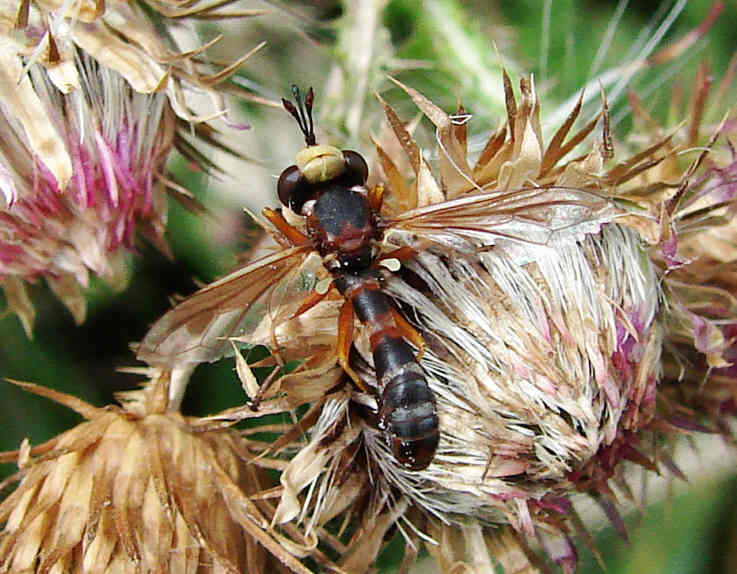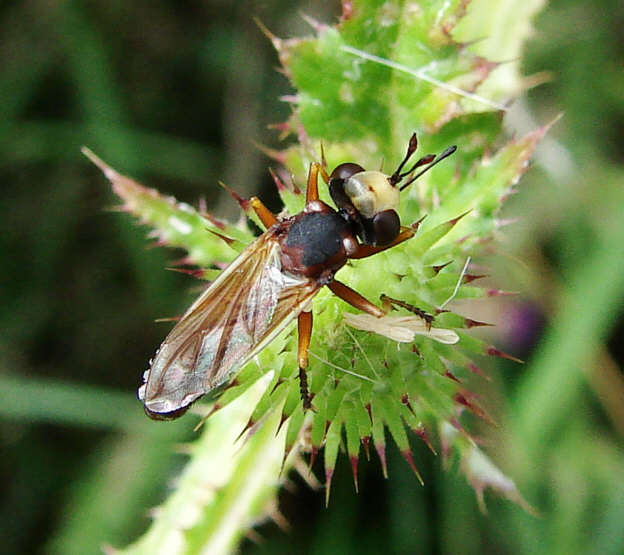Diptera.info :: Identification queries :: Diptera (adults)
|
Interesting Conopid
|
|
| Juergen Peters |
Posted on 11-07-2007 21:00
|
|
Member Location: northwest Germany Posts: 14332 Joined: 11.09.04 |
Hello! Andreas Haselb?ck asked me to post these photos here, taken today in a thistle bush in Germany (Main-Taunus-Kreis, near river Main). I thought of a Physocephala species, but not P. rufipes. Perhaps P. chrysorhoae? But I'm not sure. Can anybody help? Thanks! Juergen Peters attached the following image:  [57.35Kb] Best regards, Jürgen -=-=-=-=-=-=-=-=-=-=-=-=-=-=-=-= Juergen Peters Borgholzhausen, Germany WWW: http://insektenfo... -=-=-=-=-=-=-=-=-=-=-=-=-=-=-=-= |
| Juergen Peters |
Posted on 11-07-2007 21:01
|
|
Member Location: northwest Germany Posts: 14332 Joined: 11.09.04 |
Another picture.
Juergen Peters attached the following image:  [46.39Kb] Best regards, Jürgen -=-=-=-=-=-=-=-=-=-=-=-=-=-=-=-= Juergen Peters Borgholzhausen, Germany WWW: http://insektenfo... -=-=-=-=-=-=-=-=-=-=-=-=-=-=-=-= |
| Juergen Peters |
Posted on 11-07-2007 21:02
|
|
Member Location: northwest Germany Posts: 14332 Joined: 11.09.04 |
Third picture.
Juergen Peters attached the following image:  [47.04Kb] Best regards, Jürgen -=-=-=-=-=-=-=-=-=-=-=-=-=-=-=-= Juergen Peters Borgholzhausen, Germany WWW: http://insektenfo... -=-=-=-=-=-=-=-=-=-=-=-=-=-=-=-= |
| Jan Willem |
Posted on 12-07-2007 07:31
|
|
Member Location: Waalwijk, The Netherlands Posts: 2160 Joined: 24.07.04 |
Hi J?rgen, I first thought: You are right about this specimen not being Physocephala rufipes. With the key I end up at either P. chrysorrhoea of P. vittata. P. chrysorrhoea should have a silvery stripe at the side of the thorax from the base of the wing to the base of the middle leg. It is very well possible that this silvery stripe is present but not vissible in the position in which the picture is shot. I found that P. chrysorrhoea has been found on Blackberry and Asteraceae (= Compositae); P. vittata often on Thymus. As hosts of Physocephala chrysorrhoea Bembex intergra and Philanthus triangulum are known; as hosts of P. vittata Bombus pascuorum and B. lapidarius are known. Given the plant on which you found your specimen, Physocephala chrysorrhoea fits best. But after having a good look again (after reading the respons of Gisela on www.insektenfotos...  ), I have my doubts about Physocephala. Looking at the wing venation, it might be Conops. And again, the silvery stripe is one of the important characters used for identification ), I have my doubts about Physocephala. Looking at the wing venation, it might be Conops. And again, the silvery stripe is one of the important characters used for identification . .I will leave it for someone who realy knows Conopidae. Jan Willem Edited by Jan Willem on 12-07-2007 07:45 |
|
|
|
| Juergen Peters |
Posted on 12-07-2007 14:54
|
|
Member Location: northwest Germany Posts: 14332 Joined: 11.09.04 |
Hello, Jan Willem! Jan Willem wrote: But after having a good look again (after reading the respons of Gisela on www.insektenfotos...  ), I have my doubts about Physocephala. Looking at the wing venation, it might be Conops. ), I have my doubts about Physocephala. Looking at the wing venation, it might be Conops.Yes, I was not happy with Physocephala, the fly looks rather "conops-like". But I had never seen a Conops like this, with so much red and so few yellow, and the picture of Conops vesicularis (Gisela's assumption) did not match it very well. But she writes the specimen in the gallery is a male, which shows significant sexual dimorphism. So I would be happy if someone could confirm Conops vesicularis (female?) for this fly. Thanks! Best regards, Jürgen -=-=-=-=-=-=-=-=-=-=-=-=-=-=-=-= Juergen Peters Borgholzhausen, Germany WWW: http://insektenfo... -=-=-=-=-=-=-=-=-=-=-=-=-=-=-=-= |
| caliprobola |
Posted on 12-07-2007 15:25
|
|
Member Location: Belgium Posts: 203 Joined: 24.05.07 |
maybe take a look at the Conopidae key on the website of Mark Van Veen. In the gallery here is also a Conops vesicularis male, this looks quite different. This specimen surely looks more like a Physocephala, but i'm no expert...
Edited by caliprobola on 12-07-2007 15:41 |
|
|
|
| Gisela Merkel-Wallner |
Posted on 12-07-2007 17:49
|
|
Member Location: Germany, Bavaria, Oberpfalz Posts: 47 Joined: 05.07.05 |
Hello, as I know, Conops vesicularis is the only species of Conops in Germany, that has red in the body. In my collection I have male and female of this species. The males look like the picture in the Diptera Gallery, the female like the photos of this posting. Best regards Gisela Edited by Gisela Merkel-Wallner on 12-07-2007 17:50 |
|
|
|
| Guenter |
Posted on 12-07-2007 18:00
|
|
Member Location: Dornbirn, Austria Posts: 278 Joined: 09.12.05 |
It is definitely NOT Conops vesicularis which has its "Front reddish brown with reddish brown design" and a "Proboscis strong, only a little longer than head". To me it also looks more like a Physocephala, but I'm not sure. If it is Conops: There is another red species ocurring in central Europe (according to Chvala it has been reported from Austria and Hungary plus an unreliable report from Bohemia. Assuming that the specimen belongs to Conops it is more probably Conops flavifrons. The silverish hind borders of T3+4, the yellow frons, the yellow legs and the long, black proboscis all fit Chvala's description of C. flavifrons, exept the wings which should be "hyaline or only a little yellowish" Edited by Guenter on 12-07-2007 18:08 Günter Schwendinger |
|
|
|
| Juergen Peters |
Posted on 12-07-2007 18:07
|
|
Member Location: northwest Germany Posts: 14332 Joined: 11.09.04 |
Hello! Thanks to all again! I see, this seems to be a very interesting find... Best regards, Jürgen -=-=-=-=-=-=-=-=-=-=-=-=-=-=-=-= Juergen Peters Borgholzhausen, Germany WWW: http://insektenfo... -=-=-=-=-=-=-=-=-=-=-=-=-=-=-=-= |
| Guenter |
Posted on 12-07-2007 18:09
|
|
Member Location: Dornbirn, Austria Posts: 278 Joined: 09.12.05 |
Specimen collected?
Günter Schwendinger |
|
|
|
| Juergen Peters |
Posted on 12-07-2007 18:26
|
|
Member Location: northwest Germany Posts: 14332 Joined: 11.09.04 |
Hello, Guenter! Guenter wrote: Specimen collected? No, sorry. I think Andreas (like me) only photographs insects. Best regards, Jürgen -=-=-=-=-=-=-=-=-=-=-=-=-=-=-=-= Juergen Peters Borgholzhausen, Germany WWW: http://insektenfo... -=-=-=-=-=-=-=-=-=-=-=-=-=-=-=-= |
| Paul Beuk |
Posted on 12-07-2007 18:55
|
|
Super Administrator Location: Netherlands Posts: 19403 Joined: 11.05.04 |
I think it is Physocephala vittata: The narrowest point of the abdomen is at the posterior margin of the second segment and crossvein r-m in my view is far beyond the middle of the cell posterior of it; there appears to be no silver line on the pleura (though the humeri are silvery dusted) and the face appears to be completely yellow.
Paul - - - - Paul Beuk on https://diptera.info |
| jorgemotalmeida |
Posted on 12-07-2007 19:00
|
|
Member Location: Viseu - PORTUGAL Posts: 9296 Joined: 05.06.06 |
i think this is Physocephala sp.  In spite of venation fits better for Conops. But Physocephala sp. is my ID. In spite of venation fits better for Conops. But Physocephala sp. is my ID.  |
| Guenter |
Posted on 12-07-2007 19:55
|
|
Member Location: Dornbirn, Austria Posts: 278 Joined: 09.12.05 |
I guess Paul is right.
Günter Schwendinger |
|
|
|
| Mark van Veen |
Posted on 13-07-2007 09:52
|
|
Member Location: Zeist, Netherlands Posts: 145 Joined: 12.05.04 |
I am sure Paul is right. It is a Physocephala given the wing venation and the shape of the abdomen. It is not chrysorrhoea, which has as silverish stripe on the side of the thorax. The yellow face makes it vittata. |
| Juergen Peters |
Posted on 13-07-2007 18:53
|
|
Member Location: northwest Germany Posts: 14332 Joined: 11.09.04 |
Mark van Veen wrote: I am sure Paul is right. It is a Physocephala given the wing venation and the shape of the abdomen. It is not chrysorrhoea, which has as silverish stripe on the side of the thorax. The yellow face makes it vittata. Thank you all again! So I can tell Andreas it is Physocephala vittata Best regards, Jürgen -=-=-=-=-=-=-=-=-=-=-=-=-=-=-=-= Juergen Peters Borgholzhausen, Germany WWW: http://insektenfo... -=-=-=-=-=-=-=-=-=-=-=-=-=-=-=-= |
| Jump to Forum: |













